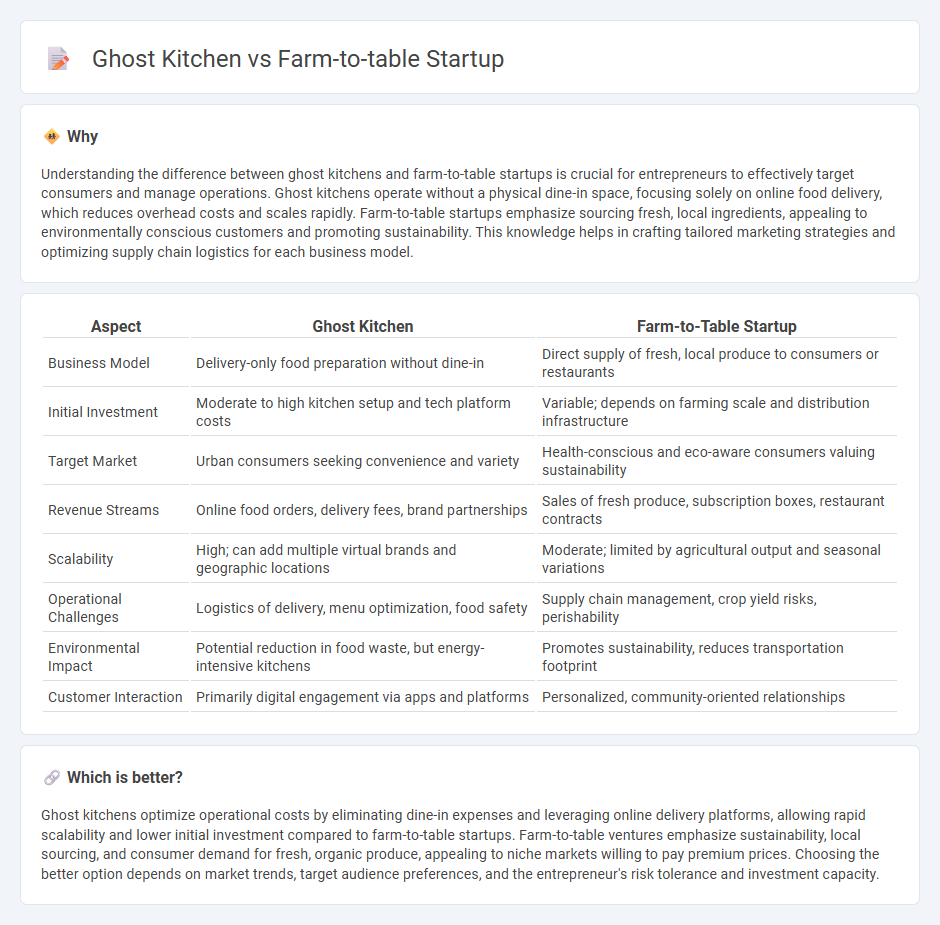
Ghost kitchens optimize food delivery by minimizing overhead and focusing solely on online orders, enabling rapid scalability and reduced operational costs. Farm-to-table startups emphasize local sourcing and fresh ingredients, appealing to consumers seeking transparency and sustainability in their dining choices. Discover the key differences and opportunities between these innovative business models in entrepreneurship.
Why it is important
Understanding the difference between ghost kitchens and farm-to-table startups is crucial for entrepreneurs to effectively target consumers and manage operations. Ghost kitchens operate without a physical dine-in space, focusing solely on online food delivery, which reduces overhead costs and scales rapidly. Farm-to-table startups emphasize sourcing fresh, local ingredients, appealing to environmentally conscious customers and promoting sustainability. This knowledge helps in crafting tailored marketing strategies and optimizing supply chain logistics for each business model.
Comparison Table
| Aspect | Ghost Kitchen | Farm-to-Table Startup |
|---|---|---|
| Business Model | Delivery-only food preparation without dine-in | Direct supply of fresh, local produce to consumers or restaurants |
| Initial Investment | Moderate to high kitchen setup and tech platform costs | Variable; depends on farming scale and distribution infrastructure |
| Target Market | Urban consumers seeking convenience and variety | Health-conscious and eco-aware consumers valuing sustainability |
| Revenue Streams | Online food orders, delivery fees, brand partnerships | Sales of fresh produce, subscription boxes, restaurant contracts |
| Scalability | High; can add multiple virtual brands and geographic locations | Moderate; limited by agricultural output and seasonal variations |
| Operational Challenges | Logistics of delivery, menu optimization, food safety | Supply chain management, crop yield risks, perishability |
| Environmental Impact | Potential reduction in food waste, but energy-intensive kitchens | Promotes sustainability, reduces transportation footprint |
| Customer Interaction | Primarily digital engagement via apps and platforms | Personalized, community-oriented relationships |
Which is better?
Ghost kitchens optimize operational costs by eliminating dine-in expenses and leveraging online delivery platforms, allowing rapid scalability and lower initial investment compared to farm-to-table startups. Farm-to-table ventures emphasize sustainability, local sourcing, and consumer demand for fresh, organic produce, appealing to niche markets willing to pay premium prices. Choosing the better option depends on market trends, target audience preferences, and the entrepreneur's risk tolerance and investment capacity.
Connection
Ghost kitchens and farm-to-table startups both revolutionize the food industry by emphasizing efficiency and direct sourcing, reducing overhead costs while prioritizing fresh, local ingredients. Ghost kitchens streamline meal preparation and delivery logistics, allowing farm-to-table startups to expand their market reach without traditional restaurant expenses. This synergy enhances sustainability and customer satisfaction by delivering fresh, locally sourced meals through optimized, technology-driven operations.
Key Terms
Farm-to-table startup:
Farm-to-table startups prioritize sourcing fresh, locally grown ingredients directly from farms, ensuring higher food quality, sustainability, and supporting local agriculture. Unlike ghost kitchens, which operate purely on delivery models without customer-facing dining spaces, farm-to-table startups often emphasize transparency and community engagement through on-site experiences or farmer partnerships. Discover how farm-to-table initiatives transform the culinary landscape and promote healthier, eco-conscious dining by exploring this innovative approach further.
Local sourcing
Farm-to-table startups prioritize local sourcing by partnering directly with nearby farms to deliver fresh, seasonal ingredients, enhancing transparency and sustainability in the food supply chain. Ghost kitchens, while efficient in delivery, often rely on centralized suppliers, which can limit their access to locally sourced produce and affect ingredient traceability. Explore the benefits of farm-to-table models in supporting local economies and improving food quality.
Traceability
Farm-to-table startups prioritize traceability by sourcing ingredients directly from local farms, ensuring transparency in the food supply chain and supporting sustainable agriculture. Ghost kitchens, while efficient for delivery, often rely on multiple suppliers, making it challenging to maintain consistent traceability across all ingredients. Discover how traceability impacts food quality and consumer trust in these innovative dining models.
Source and External Links
5 Top Farm-to-Table Solutions Impacting the FoodTech Sector - Highlights innovative startups like RealEats, which delivers chef-prepared meals using local ingredients, and Ositrade, which uses blockchain for supply chain traceability, illustrating how farm-to-table startups enhance food quality and transparency
How To Start a Farm-to-Table Establishment Business | ClickUp(tm) - Provides a step-by-step guide to launching a farm-to-table venture, emphasizing local sourcing, sustainability, and building community relationships for a healthy, eco-friendly business model
How to Start a Farm-to-Table Business: Your Guide to Success - Explains the farm-to-table concept, benefits for restaurants such as fresher food and customer loyalty, and practical tips like finding local farmers and creating menus based on seasonal, locally sourced ingredients
 dowidth.com
dowidth.com